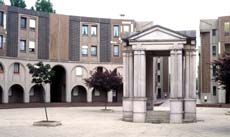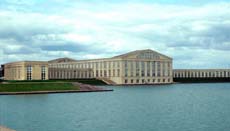index
Ricardo Bofil's buildings
click on images for full-size:





Bofil's Viaduct, at Saint-Quentin-en-Yvelines

Land-side apartments at Bofil's Arcades du lac

Courtyard amid Bofil apartments

Bofil's Temples du lac
After walking several miles with growing amazement, passing one block after another of gestures and gimmicks, I arrived at Ricardo Bofil's composition around a rectangular lake, which had been my reason for coming to Saint-Quentin. This includes three apartment complexes: les Arcades du Lac, le Viaduc, les Temples du Lac. I had not known about the third, so when I arrived I was uncertain if Bofil had designed it. As for les Arcades, the pictures I had seen did not do justice to the feel of their inner streets and courts, which created more sense of community than did the wide streets of the town. I admired the clever surface treatment Bofil has used to give very low budget buildings a better texture. However, the tiles were falling off in places; what I thought was imaginative variation in the color of the tile was just shoddy construction. The Viaduct apartments extend boldly out into the lake. Across the lake stands the third complex, built in a hollow square with wide curving wings to receive the thrust from the Viaduct. Male and female Bofil created them. This third complex, Les Temples, seen from the distance, offered a grand historical perspective, but from close up it felt empty. I walked around to see if it was a ruin, or a factory, or still under construction. Everything seemed so uniform, and there were no people; the windows were dark voids in the historicist facade. Only by stepping onto what turned out to be someone's terrace and peering into a window from four inches away could I prove to myself that there were actual inhabitants and furniture inside the blank windows. Yet this was not a sterile glass box. It was a historicizing structure with the soul of a glass box. The surrounding lawns were bare and the uniformity of the huge wings left me feeling small and antlike. Yet the building was not really so huge; it was the proportions and blankness that crushed me.